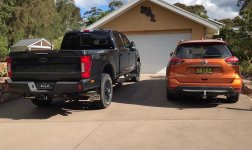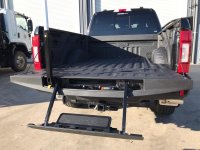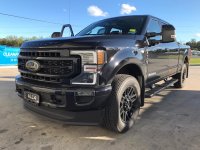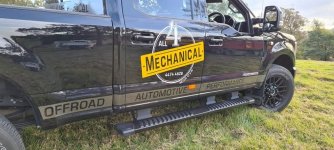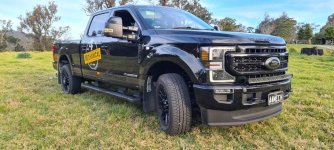This is an interesting thread on Twitter about Full Size pickup trucks in America and how they are used.
In the last five years these have become increasingly popular in Australia too. Generally I agree with the sentiments of this thread.
Content for those not on Twitter:
Pick-up trucks are ridiculous clown cars and 99% of the people who buy them will never have a practical need to own one. Here’s why:
First off, pick-ups have for years consistently been among the most popular, best selling vehicles in America. But we know from consumer surveys that almost no one who buys one uses them for anything more than daily commuting.
A Strategic Visions survey from a few years ago found that 75% of pick-up owners towed something with their vehicle one time a year or less. 70% went off-road one time a year or less. More than a third didn’t even use the bed of the truck more than once a year or less.
So the vast majority of people who buy them don’t use them for their primary design function. Which shouldn’t be surprising as the most popular models don’t really have a useful design function that can’t be fulfilled by other, smaller, cheaper vehicles.
When you think of pick-ups at the very least you’re thinking hauling lumber in the back. But most pick-ups sold are crew-cab models, which means a second row of seats in the back in exchange for less bed space. Trucks with full 8ft beds are actually remarkably unpopular.
What that means though is your average Ram 2500 Megacab is no better for hauling plywood than a base-model Toyota Sienna minivan with the seats folded down.
People don’t want to admit though that they’re driving a four-ton family sedan though. So we talk about towing capacity. Except most truck owners don’t tow with them, and those that do can’t tow as much as they think or don’t need that truck to tow what they have.
Each truck model has a fixed towing capacity. But once you start customizing the truck (as most truck owners do and they’re sold to just have endless add-one) the vehicle itself weighs more. More feature, less you can tow.
Outside of a few fifth-wheel campers, most trailers people would use can be hauled by smaller vehicles. People don’t NEED the large stuff, they get it because the truck can haul more. The bigger vehicle creates its own need.
But let’s look at the people who ostensibly use them for work: contractors, remodelers, construction workers, etc. Trucks represent a fair portion of what they drive for work, but not as much as you think. I’ve seen surveys that show only a third of remodelers drive pick-ups
The actual work-horse of American contractors and tradesmen is something closer to a Ford Transit Connect, i.e. a tall van. Enclosed storage area, infinitely customizable, 24 mpg for city driving as opposed to a Ford F-150 Supercab’s paltry 16.
Even farmers don’t for the most part drive modern pick-ups, because they’re basically useless for most farm work. Too tall, too heavy. The used trade for 90s models among agricultural workers is huge, because that was the last time trucks were made they could practically use.
And the problem with trucks getting bigger and bigger doesn’t end with them being impractical. Taller front-ends mean lower sight-lines. You become both less likely to see a pedestrian AND more likely to kill them.
I’ve seen some different stats on this but I’d say conservative estimate is that larger pick-ups and SUVs on the road has caused pedestrian fatalities increase by about a quarter since the mid 1980s. Basically all gains made in auto safety features erased over the last 40 years.
They are also ridiculously expensive vehicles. The MSRP on a base model Ford F-150 is about $29,000. But I’ll be clear, basically no one buys that. That’s a single-row seating vehicle with an AM/FM radio in it.
The same model fully-loaded, like you go down the features list and check every box, will run you close to $80,000. That’s basically luxury car prices. And most the people buying them are going to finance some or most of that, so just go ahead and add $10-20,000 to that.
I’ve said this before, but car dealerships do not sell cars, they sell debt with a car attached.
Now you can think up a myriad of examples of how you, personally, need a pick-up or the one time that it was useful to have one or whatever. But your experience is stacked against the literal millions of pick-up owners who bought them as engorged status symbols.
The fact is most practical uses of a pick up can be handled just as well 1) in a smaller vehicle 2) are so uncommon that it’s cheaper to occasionally rent something. Owning a truck the size of a WWII Sherman tank serves no practical purpose and makes you look fucking ridiculous
If you like this thread and want to support other things I do there’s
@SynodusPod
which is not a truck but is a history podcast about death.
Gonna reiterate this because it keeps coming up but “you” and “most people” are not the same thing. You personally having a regular use for a large new pick-up is not a counterpoint to the fact the VAST majority of people who buy them are suburbanites buying a status symbol.
Your personal experience isn’t the same as sales figures and consumer surveys. If you think it’s great that a bunch of middle managers are out there buying four tons of steel with the acceleration of a 1990s Ferrari to pick up their kids from school, then whatever.
Some people have brought up snow and ice conditions, which, fuckin’ lol. First off if you’re regularly driving in snow deep enough to justify a pick-up and you don’t have a plow attached to the front then you 1) work on a farm or for the Forest Service or 2) are a fucking moron
If you’re talking about icy roads then you’re talking about just adding weight and momentum to a situation where stopping isn’t happening easily. Consistently best-rated winter drivers are almost always AWD sedans.
If you personally can think of situations on ice where a truck is better than a Subaru Outback and ISN’T just going to fishtail your ass into a curb, then good for you but I guarantee your insurance company begs to differ, and they have a bigger dataset than you.
In the last five years these have become increasingly popular in Australia too. Generally I agree with the sentiments of this thread.
Content for those not on Twitter:
Pick-up trucks are ridiculous clown cars and 99% of the people who buy them will never have a practical need to own one. Here’s why:
First off, pick-ups have for years consistently been among the most popular, best selling vehicles in America. But we know from consumer surveys that almost no one who buys one uses them for anything more than daily commuting.
A Strategic Visions survey from a few years ago found that 75% of pick-up owners towed something with their vehicle one time a year or less. 70% went off-road one time a year or less. More than a third didn’t even use the bed of the truck more than once a year or less.
So the vast majority of people who buy them don’t use them for their primary design function. Which shouldn’t be surprising as the most popular models don’t really have a useful design function that can’t be fulfilled by other, smaller, cheaper vehicles.
When you think of pick-ups at the very least you’re thinking hauling lumber in the back. But most pick-ups sold are crew-cab models, which means a second row of seats in the back in exchange for less bed space. Trucks with full 8ft beds are actually remarkably unpopular.
What that means though is your average Ram 2500 Megacab is no better for hauling plywood than a base-model Toyota Sienna minivan with the seats folded down.
People don’t want to admit though that they’re driving a four-ton family sedan though. So we talk about towing capacity. Except most truck owners don’t tow with them, and those that do can’t tow as much as they think or don’t need that truck to tow what they have.
Each truck model has a fixed towing capacity. But once you start customizing the truck (as most truck owners do and they’re sold to just have endless add-one) the vehicle itself weighs more. More feature, less you can tow.
Outside of a few fifth-wheel campers, most trailers people would use can be hauled by smaller vehicles. People don’t NEED the large stuff, they get it because the truck can haul more. The bigger vehicle creates its own need.
But let’s look at the people who ostensibly use them for work: contractors, remodelers, construction workers, etc. Trucks represent a fair portion of what they drive for work, but not as much as you think. I’ve seen surveys that show only a third of remodelers drive pick-ups
The actual work-horse of American contractors and tradesmen is something closer to a Ford Transit Connect, i.e. a tall van. Enclosed storage area, infinitely customizable, 24 mpg for city driving as opposed to a Ford F-150 Supercab’s paltry 16.
Even farmers don’t for the most part drive modern pick-ups, because they’re basically useless for most farm work. Too tall, too heavy. The used trade for 90s models among agricultural workers is huge, because that was the last time trucks were made they could practically use.
And the problem with trucks getting bigger and bigger doesn’t end with them being impractical. Taller front-ends mean lower sight-lines. You become both less likely to see a pedestrian AND more likely to kill them.
I’ve seen some different stats on this but I’d say conservative estimate is that larger pick-ups and SUVs on the road has caused pedestrian fatalities increase by about a quarter since the mid 1980s. Basically all gains made in auto safety features erased over the last 40 years.
They are also ridiculously expensive vehicles. The MSRP on a base model Ford F-150 is about $29,000. But I’ll be clear, basically no one buys that. That’s a single-row seating vehicle with an AM/FM radio in it.
The same model fully-loaded, like you go down the features list and check every box, will run you close to $80,000. That’s basically luxury car prices. And most the people buying them are going to finance some or most of that, so just go ahead and add $10-20,000 to that.
I’ve said this before, but car dealerships do not sell cars, they sell debt with a car attached.
Now you can think up a myriad of examples of how you, personally, need a pick-up or the one time that it was useful to have one or whatever. But your experience is stacked against the literal millions of pick-up owners who bought them as engorged status symbols.
The fact is most practical uses of a pick up can be handled just as well 1) in a smaller vehicle 2) are so uncommon that it’s cheaper to occasionally rent something. Owning a truck the size of a WWII Sherman tank serves no practical purpose and makes you look fucking ridiculous
If you like this thread and want to support other things I do there’s
@SynodusPod
which is not a truck but is a history podcast about death.
Gonna reiterate this because it keeps coming up but “you” and “most people” are not the same thing. You personally having a regular use for a large new pick-up is not a counterpoint to the fact the VAST majority of people who buy them are suburbanites buying a status symbol.
Your personal experience isn’t the same as sales figures and consumer surveys. If you think it’s great that a bunch of middle managers are out there buying four tons of steel with the acceleration of a 1990s Ferrari to pick up their kids from school, then whatever.
Some people have brought up snow and ice conditions, which, fuckin’ lol. First off if you’re regularly driving in snow deep enough to justify a pick-up and you don’t have a plow attached to the front then you 1) work on a farm or for the Forest Service or 2) are a fucking moron
If you’re talking about icy roads then you’re talking about just adding weight and momentum to a situation where stopping isn’t happening easily. Consistently best-rated winter drivers are almost always AWD sedans.
If you personally can think of situations on ice where a truck is better than a Subaru Outback and ISN’T just going to fishtail your ass into a curb, then good for you but I guarantee your insurance company begs to differ, and they have a bigger dataset than you.



